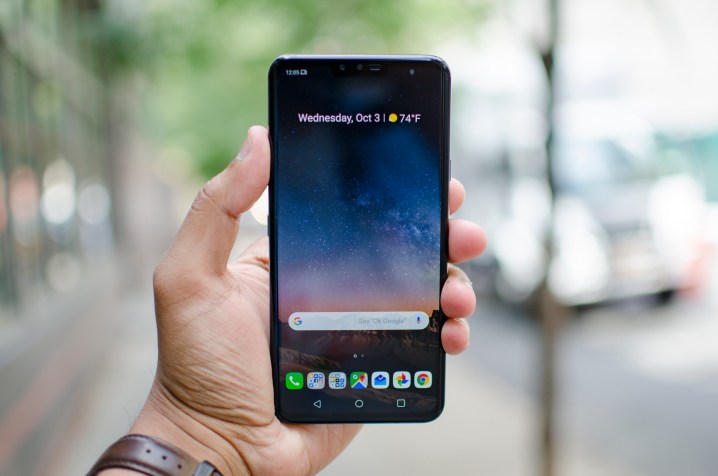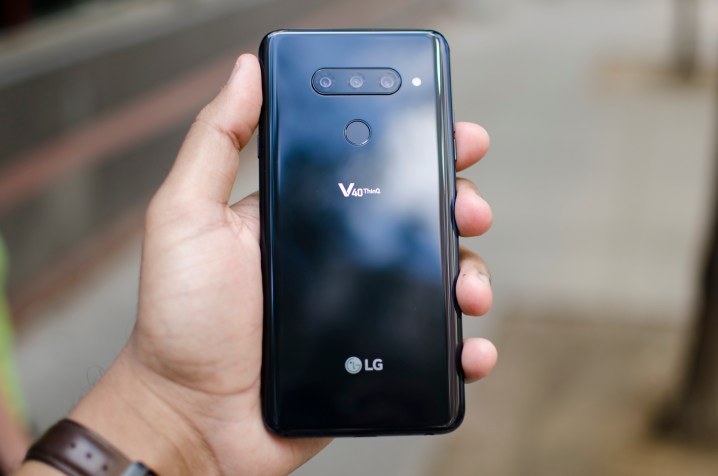
LG hasn’t had the success it wanted or deserved in the smartphone market over the last couple of years and so it seems to be switching tactics to a smartphone update policy that sees it roll out relatively small improvements more often. We’ve seen new V Series phones three times in just over a year and spotting the differences can be a challenge. In fact, the LG V30 and V30S ThinQ are so similar that we’ve just included the V30 here.
The new LG V40 ThinQ has some very clear and definite advantages over its predecessors, but you always pay a premium for the latest devices. Is it worth paying the extra or should you snag a bargain? Which of LG’s big video phones is the best for you?
Specs
| LG V40 ThinQ |
LG V35 ThinQ | LG V30 | |
| Size | 158.7 x 75.7 x 7.7mm (6.25 x 2.98 x 0.30 inches) | 151.6 x 75.4 x 7.4 mm (5.97 x 2.97 x 0.29 inches) | 151.6 x 75.4 x 7.4 mm (5.97 x 2.97 x 0.29 inches) |
| Weight | 169 grams (5.96 ounces) | 158 grams (5.57 ounces) | 158 grams (5.57 ounces) |
| Screen size | 6.4-inch P-OLED | 6-inch P-OLED | 6-inch P-OLED |
| Screen resolution | 3,120 x 1,440 pixels (537 pixels per inch) | 2,880 x 1,440 pixels (537 pixels per inch) | 2,880 x 1,440 pixels (537 pixels per inch) |
| Operating system | Android 8.1 Oreo | Android 8.0 Oreo | Android 7.1.2 Nougat |
| Storage space | 64GB | 64GB, 128GB | 64GB, 128GB |
| MicroSD card slot | Yes | Yes | Yes |
| Tap-to-pay services | Google Pay | Google Pay | Google Pay |
| Processor | Qualcomm Snapdragon 845 | Qualcomm Snapdragon 845 | Qualcomm Snapdragon 835 |
| RAM | 6GB | 6GB | 4GB |
| Camera | Triple lens 12MP (with OIS) and 16MP wide and 12MP telephoto rear, dual 8MP and 5MP wide front camera | Dual lens 16MP (with OIS) and 13MP wide rear, 8MP front camera | Dual lens 16MP (with OIS) and 13MP wide rear, 5MP front camera |
| Video | 4K at 60fps, 1080p at 240fps | 4K at 30fps, 1080p at 60fps, 720p at 120fps | 4K at 30fps, 1080p at 60fps, 720p at 120fps |
| Bluetooth version | Bluetooth 5.0 | Bluetooth 5.0 | Bluetooth 5.0 |
| Ports | USB-C 2.0 | USB-C 1.0 | USB-C 1.0 |
| Fingerprint sensor | Yes (back) | Yes (back) | Yes (back) |
| Water resistance | IP68 | IP68 | IP68 |
| Battery | 3,300mAh
Fast charging (Qualcomm Quick Charge 3.0) Qi wireless charging |
3,300mAh
Fast charging (Qualcomm Quick Charge 3.0) Qi wireless charging |
3,300mAh
Fast charging (Qualcomm Quick Charge 3.0) Qi wireless charging |
| App marketplace | Google Play Store | Google Play Store | Google Play Store |
| Network support | T-Mobile, AT&T, Verizon, Sprint | T-Mobile, AT&T, Verizon, Sprint | T-Mobile, AT&T, Verizon, Sprint |
| Colors | Aurora black, Moroccan blue | Aurora black, Platinum gray | Aurora black, Cloud silver, Moroccan blue, Lavender violet, Raspberry rose |
| Price | $900+ | $850 | $600+ |
| Buy from | LG | Amazon | Amazon |
| Review score | 3.5 out of 5 stars | 4 out of 5 stars | 4 out of 5 stars |
Performance, battery life, and charging

Considering the V40 and the V35 both have Qualcomm’s Snapdragon 845 processor inside with 6GB of RAM and you can immediately see that we have our work cut out separating these phones. Based on our early benchmark testing, the V35 ThinQ is a slightly better performer than the V40. Though it’s no slouch, we can easily eliminate the V30 here as it has the older Snapdragon 835 processor and 4GB of RAM, which means it can’t keep up with the newer devices. All three come with 64GB of storage and offer expansion via a MicroSD card slot.
There is no help in the battery and charging department because all three of these phones have batteries rated at 3,300mAh with support for fast charging and wireless charging. We could argue that the V40 has the biggest display to power and the V30 has a less efficient processor, so it’s likely that the V35 will last the longest between charges, but we’re not detecting a big difference between these phones in terms of battery life.
Winner: LG V35 ThinQ
Design and durability

The LG V30 sports a minimalist design. A curved metal chassis is sandwiched by glass front and back. Small bezels flank the display, while a fingerprint sensor sits below a protruding dual lens camera module on the back. It’s an attractive phone, if a little lacking in personality. The LG V35 ThinQ is physically identical.
The LG V40 ThinQ is obviously bigger, as it has to accommodate a larger display, but the bezels have been shrunk down and there’s a notch for the front-facing camera, so it isn’t much bigger. On the back, a third lens has joined the camera module, but it’s still clearly part of the same family. All three are surprisingly light when you pick them up, which is great if you find larger phones a bit too heavy but can also detract from the premium feel.
These phones all offer IP68 water resistance, which means they can be submerged in shallow water for up to 30 minutes without suffering permanent damage. They are all going to pick up scratches, scuffs, or even cracks if you drop them, so pick a good case for whichever model you opt for.
Winner: LG V40 ThinQ
Display

With identical 6-inch OLED screens with 18:9 aspect ratios and 2,880 x 1,440-pixel resolutions, the V30 and V35 ThinQ cannot be separated here. The V40, however, expands the OLED screen to 6.4 inches and adopts a 19.5:9 aspect ratio. It has a 3,120 x 1,440-pixel resolution, which makes it slightly sharper than its predecessors, though the notch means that not all of the extra screen real estate is usable all the time.
All these displays look great for watching movies, reading, or gaming on. OLED technology is superior to LCD, especially with regard to contrast, as switching pixels on and off individually, instead of relying on a backlight allows you to get true blacks. Though we’re not fans of the notch, we’re going to give the V40 the win here for the bigger display.
Winner: LG V40 ThinQ
Camera

The LG V30 has a dual-lens camera that pairs a 16-megapixel lens with a wide-angle 13-megapixel lens. While it’s a decent camera setup, there are plenty of phones on the market with better cameras, and we’ve been a little disappointed with the results, especially in low light. The V30S ThinQ added some A.I. smarts to the camera, which are also in both the newer phones, but they won’t make a big difference to your experience with it. The V35 has the same camera module as the LG G7, which still suffered in low light, but it did bring a slight improvement to the front-facing camera which jumped from 5 megapixels to 8 megapixels.
Major improvements in the LG V40, at least on paper, see the addition of two lenses. The main camera is a triple-lens affair that combines a 12-megapixel main lens with optical image stabilization, a 16-megapixel wide angle lens, and a 12-megapixel telephoto lens for zooming in on subjects. It should be much better at capturing shots with sharp subjects and blurred backgrounds than its predecessors. We’re also pleased to hear that the pixel size in the standard lens is larger for better low-light performance (with a slightly larger image sensor as well). Round the front, LG has added a 5-megapixel wide lens to the standard 8-megapixel lens, which should be ideal for group selfies.
In case you have been wondering, the V stands for video and all three of these phones are adept at capturing it. If you dig into the video apps, you will find a laundry list of filters and other customization options. The V40 has some extras, like the option to shoot cinemagraphs, which allow you to capture a scene and then choose to animate just part of it, so a subject can be moving while their surroundings are frozen in time like a photo.
Winner: LG V40 ThinQ
Software and updates

It’s disappointing to see the LG V40 ThinQ ship with Android 8.1 Oreo when Android 9.0 Pie is available. We’re sure it will be updated, but you might be waiting a while. The V30 shipped with Nougat, but has since been updated to Android 8.0 Oreo. Your experience on these devices is going to be pretty similar, with LG’s interface over Android, but with the newest version of Android, a handful of extras, and the greatest likelihood of being supported for updates for longer, the V40 wins here.
Winner: LG V40 ThinQ
Special features
The V Series is all about video and that’s where you find the features that set these phones apart from the rest of the market. As the newest of the bunch, it will come as no surprise that the LG V40 ThinQ has the most video tricks up its sleeve.
Winner: LG V40 ThinQ
Price
As top-of-the-line devices, the V Series tend to be expensive. You can pick up an LG V30 for $600 now, whereas an LG V35 ThinQ will probably cost you $850. Obviously, these prices will continue to fall, especially now the V40 is out, so it’s worth shopping around. The LG V40 ThinQ starts at $900. All three offer support for all the major carriers, provided you buy the right model.
Overall winner: LG V40 ThinQ
It would be a sign that there was something seriously wrong if the V40 wasn’t the best phone here and it comfortably is. If you opt for it, then the extra outlay will net you a much more versatile camera and a bigger screen. If those things aren’t important to you, then the V35, or even the V30, could save you quite a lot of money without any major compromises.


